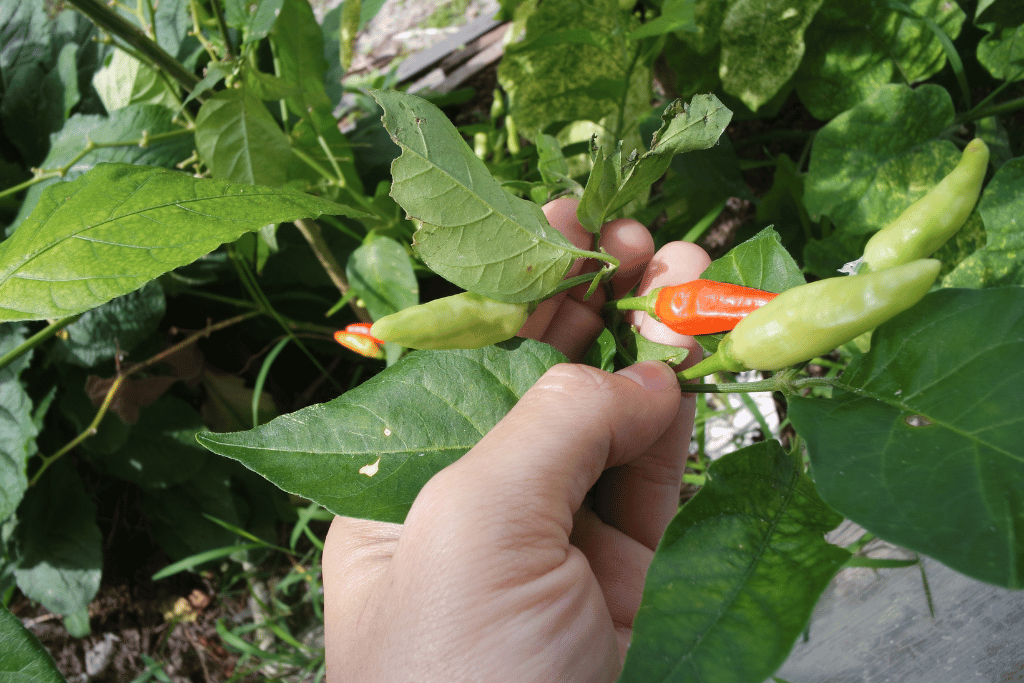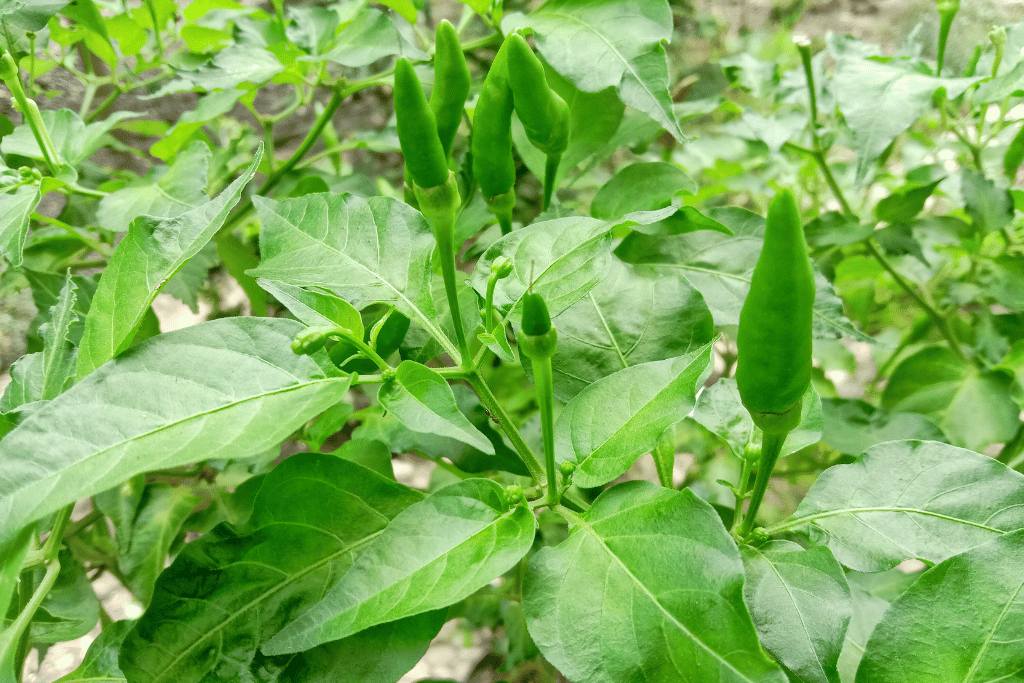
Knowing when to pick cayenne peppers is crucial to achieving the best taste and flavor from your harvest. In the following sections I’ll cover everything you need to know about this piquant fruit, so, whether you’re a seasoned gardener or a cooking enthusiast, you’ll find valuable insights on how to cultivate, maintain, and harvest them. Therefore, if you’ve been wondering “When are cayenne peppers ready to be picked?” you’re just at the right place!
Cayenne Pepper Key Facts
The cayenne pepper, scientifically known as Capsicum annuum belongs to the Solanaceae family and originally hails from South America but is now grown globally and is widely used in various cuisines.
When it comes to growing the plant and waiting for its produce to ripen, one may wonder when to pick cayenne peppers off the plant. The answer to this question depends on the desired level of spiciness, as the heat level of the fruit falls in the middle of the Scoville heat scale, ranging from 30,000 to 50,000 units. In short, if you can handle some massive hotness, gather the fruits once they turn red. However, in case you rather prefer mild heat, you may detach them off the stems while still green. No worries – they’re perfectly edible this way too!
The plant itself has a one-of-a-kind appearance, with its slender green stems, lush foliage, and elongated, dark green leaves that form an attractive contrast to the bright red and thin peppers hanging from the branches. The produce itself measures up to 6 inches (15 centimeters) in length and tapers to a sharp point. When mature, its skin becomes smooth, and shiny with a flaming color, containing a rich and distinctive aroma.
Most Popular Types of Cayenne Pepper
- Long hot thin: This variety is commonly used in Italian cuisine and is believed to have originated in Southern Italy.
- Purple cayenne: This fruit is native to French Guiana, and due to its enchanting deep purple color, is a beloved ornamental element in several dishes.
- Red ember: This kind of pepper hails from the Americas, specifically in Mexico and South America.
- Serrano: A true Mexican native, named after the mountains of the same name in the regions of Puebla and Hidalgo.
- Aleppo: The name of this strong pepper comes from the city of Aleppo in Syria, where the plant has been a staple ingredient in Middle Eastern cuisine for centuries
- Tabasco: Even though the famous Tabasco pepper is originally from the Mexican state of Tabasco, it is now mostly associated with the hot sauce of the same name, which is produced in Louisiana, USA.
Most Well-Known Uses

- Dehydration: Cayenne peppers can be dried and ground into a fine powder, which is then used as a spice to add heat to a variety of dishes.
- Salsa and hot sauce: Cayennes are a must ingredient in many salsa and hot sauce recipes. They also blend really well with other elements like tomatoes, onions, and garlic to create a flavorful condiment.
- Frying: They make an excellent crunchy and spicy topping for salads, soups, and other dishes.
- Cloning: If you have freshly picked cayenne peppers, you can save the seeds to plant and grow your own pepper plants.
- Pickling: Once pickled in vinegar, these hotties are ready to be used as a condiment or topping for sandwiches and burgers.
- Infused oil: Infuse the fruits in oil to create a pungent cooking oil that adds heat to any dish.
- Rubs: If you mix cayenne pepper with other spices, you get an exciting and unique dry rub for meats like chicken, pork, and beef.
- Tea: Tea made of the plant is a popular remedy for cold and flu symptoms, as well as a digestion aid.
- Marinades: Cayennes are often added to marinades for meats and vegetables to provide a spicy kick to their flavor.
- Roasting: These delicate and bright fruits go exceptionally well with stews, soups, and chili to add a smoky and heated taste.
Cayenne Pepper Growth Phases
Understanding the development phases of this plant contributes to identifying when cayenne peppers are ready to be picked. In order to execute a successful harvest, get familiar with the key growth stages first:
- Seedling stage: The first phase starts with seed planting. During this period, the seedlings will emerge from the soil within 10-14 days of planting. Ensure to maintain a temperature between 70-80°F (21-27 Celsius) a pH of 6-7, and well-drained soil.
- Vegetative phase: The plant continues development from the emergence of the first true leaves until the flowering stage. This is the time when the greenery will develop strong stems, roots, and more leaves to increase its foliage capacity. Proper nutrients, irrigation, and lighting are essential for this.
- Flowering period: In the third stage, the plant will begin to produce flowers. At this point, it’s crucial to maintain good humidity levels and consistent watering to avoid flower drops.
- Fruiting stage: The fourth and final stop is called fruiting. This is when the cayenne pepper starts to produce fruits. They will first be green and then mature to red. Sustain appropriate hydration and nutrient levels to promote healthy and unblocked growth.
When To Pick Cayenne Peppers

It’s good news that the plant is easy to grow for its zestful produce in relatively any home garden that has the right conditions. However, knowing when to pick cayenne peppers off the plant is crucial to get the best taste and flavor from your harvest.
First, if you’re going for the ultimate spiciness, it’s recommended to wait until the peppers have reached full maturity before harvesting them. Cayenne peppers typically take around 70-80 days to ripen from the time of planting. Once they have turned brilliant red and are firm to the touch, it’s time to collect them.
Remember: If you don’t want to light your taste buds on fire, gather the fruits while still green for a less intense flavor.
For the operation, use a pair of scissors or garden shears to cut the peppers high enough on the stem, especially if you wish to dehydrate them. It’s also essential to harvest cayenne peppers regularly to encourage more fruit production. As you collect the ripe fruits, new buds will form, and the plant will continue to produce throughout the growing season.
Reasons For Cayenne Pepper Not Turning Red

One factor that may create doubt about when to pick hot cayenne peppers is them not achieving their distinctive flame-colored shade. A common reason for this occurrence is a lack of adequate sunlight, which may be caused by external elements such as excessive cloud cover or the presence of large objects obstructing the sunlight.
Other possible hindrances may include genetic mutations or variations in the plant’s growth or developmental patterns.
Additionally, pests or diseases might also impact the greenery’s ability to mature and ripen properly. Suitable care and maintenance of your greens, including ensuring the appropriate amount of sunlight exposure, regular pest control measures, and timely harvest, can help to promote the overall health and ripening of your peppers.
Thoughts For Takeaway
In the dance of life, the vivacious cayenne pepper waltzes from the garden to our plates, bringing a fiery zest to the culinary world. Now that you know when to pick cayenne peppers, embrace the knowledge and passion for this pungent fruit, and let it guide you to a harmonious relationship with nature. Savor the heat, relish the flavor, and let the plant’s tale unfold in your garden of delights.
Frequently Asked Questions (FAQ)
How to know when to pick cayenne peppers?
On average, cayenne peppers require 70-80 days from planting to reach maturity. Firmness, a brilliant red shade, and fruits of about 4-6 inches indicate ripeness. In addition, they should also have a spicy aroma and taste. It’s best to pick them when they are fully developed for maximum flavor and heat.
How long do cayenne Peppers last?
Cayenne peppers can last for up to two weeks when stored properly. It’s best to keep them in the refrigerator in a paper or plastic bag to help retain their freshness. Alternatively, they can be dried or frozen for long-term storage, which can extend their shelf life for several months.
What’s hotter, jalapeno or cayenne pepper?
In general, cayenne pepper is hotter than jalapenos. On the Scoville scale, which measures the heat level of peppers, the Jalapeno ranges from 2,500 to 8,000 Scoville Heat Units (SHU), while cayennes are typically between 30,000 – 50,000 SHU. However, the heat level can vary depending on the specific varieties.
Are cayenne and chili peppers the same?
No, they are not exactly the same, but come from the Capsicum family and can be used interchangeably in many recipes.
What are the health benefits of cayenne pepper?
Cayenne pepper has several potential beneficial properties, including its ability to reduce inflammation, improve digestion, boost metabolism and circulation, relieve pain, and aid in weight loss.



